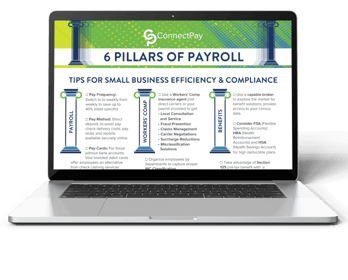
As your team’s employer, you want to offer them the best benefits you can provide. But the reality is that quality coverage is painfully expensive for many hard-working employees and their families.
Section 125 Premium Only Plans (POPs) can help your employees stretch their benefit dollars further.
By setting up pretax deductions, you can reduce your team’s taxable income, so more money goes towards their actual healthcare instead of taxes. Employees can save hundreds annually, meaning less financial stress and greater loyalty and retention to your business.
How it works:
When employees contribute to their benefits through a Section 125 plan, such as health insurance premiums, those contributions are deducted from their gross pay before taxes are calculated.
As a result, the taxable income of participating employees is reduced, leading to lower payroll taxes for you and your employees. And because pretax contributions lower employees' taxable income, both parties pay less in FICA taxes. Everybody wins!
Intrigued by these benefits but overwhelmed by complex IRS regulations? This article will break down the in’s and out’s of Section 125 Premium Only Plans.
By the end, you’ll be equipped with four aspects of POP plans to evaluate when deciding whether or not to offer POP benefits as part of your compensation plan for your small business.
Section 125 Premium Only Plans: The 411
A Section 125 Premium Only Plan (POP) is a valuable type of cafeteria plan that lets employees set aside a portion of each paycheck before taxes are calculated to cover health insurance premiums–resulting in a higher net pay!
As we briefly covered above, premium-only plans offer several benefits to both employers and employees. POPs reduce your participating employees' taxable income (since deductions happen before calculating federal, state, and payroll taxes on their earnings). As a result, your team gets more take-home pay than paying for benefits with after-tax dollars. They also save significant money over time on expenses like premiums when paid pretax through a POP.
Section 125 Premium Only Plans simplify payroll administration for you or your payroll administrator by allowing batch deductions. And your employees will be happy! By offering pretax benefits to your team, your commitment to empowering and retaining your hard-working employees shines!
Experienced payroll providers like us at ConnectPay can help you make sure you’re meeting compliance regulations with your Section 125 plan by helping you create a Plan Document. The Section 125 Plan Document legitimizes your pretax contributions through the IRS. Without a compliant Section 125 Plan Document you run the risk of incurring fines, penalties, an audit, or subsequent investigation from the IRS. Your valued employees will lose the benefit of taking deductions on a pretax basis.
Have questions about maintaining compliance with your current Section 125 Plan Document? Or if you need to get one started, explore our new product, Connect Section 125! We’re here to help!
1. What Expenses Can a POP Cover?
A Section 125 Premium Only Plan helps your team pay for various benefit-related expenses on a pretax basis. Specific expenses include premiums for:
- Medical, prescription drugs, mental health, and substance abuse treatments
- Dental and vision insurance
- Flexible spending account (FSA) contributions that reimburse qualified medical expenses
- Health savings account (HSA) contributions for future health expenses
Certain accident and disability insurance policies also offer benefits for loss of life, limb, sight, etc. Specifically, eligible accident and disability premiums include those associated with accidents, some diseases, and disability policies that compensate for unfortunate life events or loss of abilities.
As long as the program meets the IRS's definition of accident and health coverage, your employees can use pretax POP funds to pay premiums.
2. What is Not Eligible Under a POP?
While Section 125 Premium Only Plans cover a wide range of health-related insurance premiums, here are some notable exceptions that don’t qualify for pretax treatment:
- Life insurance premiums (except for limited premiums providing an excess death benefit)
- Short-term and long-term disability insurance premiums
- Premiums for wage replacement or income protection plans
- Pet insurance
- Long-term care insurance
- Nursing home, home health, and long-term care insurance premiums
However, there are some grey areas to consider. For example, life insurance is not typically covered, but it can be eligible if a small portion of the small business policy provides an excess death benefit linked to accidental loss of life.
Pro Tip: A quick rule of thumb is to ask yourself, "Is this premium directly supporting a health, dental, vision, or accident policy that pays medical benefits if something happens to me?" If the answer is "yes," then the premium is generally POP-eligible.
3. How Exactly Does a POP Work?
The process starts when you, as an employer, choose an accredited POP provider to establish a plan that outlines which benefit premiums will be offered for a pretax deduction. Once you’ve selected a plan to offer, select an annual Open Enrollment period (typically a few weeks) where your employees can decide whether or not to opt into the plan.
During open enrollment, employees elect which coverages they want and assign contribution amounts for each selected benefit's premium deduction from their paycheck. These contributions are withheld before federal, state, and payroll taxes are calculated on that team member’s income. Premiums are then combined for all employees and paid to insurance companies using the shared POP funds.
One unique factor is that Section 125 Premium Only Plans require a “use-it-or-lose-it” approach – any unused funds left at year-end are returned to or forfeited by the employer. However, the carryover provision implemented in 2013 lets plan participants extend up to $500 of unused POP funds to apply toward qualified expenses the following year.
4. What Compliance Concerns Should I Be Aware Of?
It is important to operate a POP according to the laws and regulations to ensure legal compliance and keep your employees satisfied. Part of this compliance is non-discrimination testing, ensuring that your plan does not unfairly benefit highly paid employees.
For instance, providing the CEO with significantly more pretax compensation than a junior employee would violate the rules. Consistent oversight is necessary to maintain compliance with regulations such as Section 125, tax codes, and the Employee Retirement Income Security Act of 1974 (ERISA).
Falling out of compliance risks consequences like IRS fines or fees, real-time costs to correct plan administration errors, and dissatisfied staff who don’t feel fairly treated (like the likely result in the example above!).
Whether you implement one or not, approach Section 125 Premium Only Plans with intention. No organization wants to deal with financial penalties, rush problem-solving, or explain to employees why the plan unexpectedly changed.
Section 125 Premium Only Plans: Your Next Step
When strategically leveraged, section 125 Premium Only Plans offer valuable long-term savings for employers and your team. Though the nuances of laws and testing sound complex, experienced providers simplify program administration, helping you create a valuable turnkey solution that requires minimal upkeep and maximum value for your team.
Assessing your unique organizational needs with a trusted payroll and compliance advisor is the ideal first step. An expert partner like ConnectPay can ensure you make fully informed decisions and maintain ongoing operational success.
We don’t offer Section 125 plans here at ConnectPay, but we can help you find trusted, local brokers to explore your options. If you already have a Section 125 Plan but need a Plan Document, we can help you, too! Our new product Connect Section 125 is an affordable vehicle to master Section 125 Plan Document compliance for your small business! Our portal and its tools can help you manage Section 125 compliance all year long.








